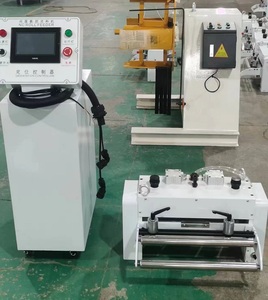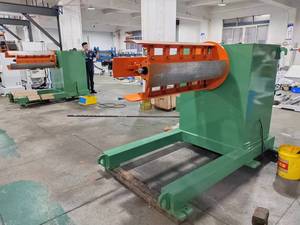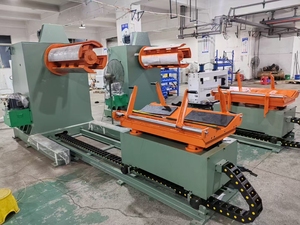(2608 products available)























































































































































































































An automatic coil feeder is an equipment that can automatically supply materials from a coil to a punch or press machine. It is an essential piece of machinery that helps to improve production efficiency and streamline the feeding process. There are several types of automatic coil feeders:
Lift Table Coil Feeder
A lift table coil feeder provides material at a convenient height to operators or machines. It has an adjustable table, which can be electric, hydraulic, or manual. A lift table coil feeder can be used with a part stacker for complete operational assistance.
Hold Downs Spring Loaded
Hold downs spring-loaded provide automatic coil feeds to springs, which provide consistent pressure to hold coil stock down. This allows the stock to move freely through the feeder without any hindrances. This kind of automatic feeder is useful for low- to high-production facilities.
Auction Style Coils
An auction-style coil hold-down works like an auction paddle. When stock is loaded into a conveyor belt feeder, the paddles come down and hold the stock down. This type of coil is advantageous because it does not apply side pressure to the material. Therefore, it is ideal for fragile or sensitive material. The auction-style coil can be found inside of a continuous feed conveyor belt system.
Coil Feather Strap
A coil feeder strap holds coils of different gauge materials. It moves directly onto the feeder or conveyor belt. The strap supports the coil and maintains its structure until it is fed into the operation line. A coil feeder has a smooth, flat surface and holds the material longer than conventional hoppers.
Press & Shear Tooling Coils
Press and shear coil feeders are usually integrated with different types of industrial presses. They can handle various materials and gauges. The spring-loaded hold-downs apply only enough pressure to shear or press the coil without distorting it. The machine operators can center the material to fit within the tooling.
Automatic coil feeders' specifications vary depending on the types and machineries they are designed for. Here are key specifications to consider when looking for an appropriate coil feeder.
Material Thickness Range
Different feeders work with different materials. The thickness needs to be within a specific range for the feeder to work well. Some feeders can handle thin materials, while others are made for thicker ones.
Width and Diameter of the Material
The feeder's machine matches the material it feeds in terms of height and width. If it's too big or small, it won't work right.
Speed and Capacity
Each automatic coil feeder has a speed and capacity it can do. These numbers tell how fast the feeder works and how much material it can handle in a day.
Control System
Different feeders have distinct control systems. Some have a digital screen for easy operation and precise control. Others use buttons and switches for a more straightforward, traditional way of working.
It is also essential to note that maintaining the feeder is as crucial as choosing it. Fortunately, manufacturers recommend simple maintenance procedures. It helps the equipment to work promptly and efficiently. First, it is necessary to lubricate the feeder parts regularly. Second, they keep the coil feeder clean. Third, it is essential to conduct routine inspections and part replacements to identify problems promptly and avoid the risk of mechanical failure.
Automatic coil feeders are widely used in different industries and have become crucial in production lines. Here are some applications of coil feeders:
When choosing an automatic coil feeding machine, there are some factors to consider to ensure it satisfies specific requirements. One important factor to look at is the machine's compatibility with its application. Buyers should note that the feeder will only work excellently with the right type and size of coil. To ensure compatibility, buyers should understand the materials' dimensions, weights, and specifications they intend to use the feed for. This understanding also extends to the processes the feeders will be used for (welding, stamping, etc.).
Another vital feature to consider is the automatic coil feeder's coil capacity and supply rate. This refers to the maximum amount or number of coils the feed can hold. Businesses with high production rates will do well with feeders with large capacities. Such feeders also have a rapid feed rate with frequent feeding.
Consider the type of coil feeder for the machine's application. Different types of automatic coil feeders work better with specific setups. For example, a belt-driven feeder will work better for a stamping machine. Analyze the automatic coil feeder's functions, designs, and working principles before choosing one for a business.
Ultimately, a buyer's choice is subject to the budget. It helps to consider the costs of the automatic feeder and the amount to be spent before the business begins looking for options. Comparing different suppliers and their products helps determine what stays within budget.
Q1: How are automatic coil feeders used in press lines?
A1: In press lines, automatic feeders are directly linked to the die press. The feed rolls are linked to the stroke of the press with a rolled mapping command so that material is fed into the die at the right time.
Q2: What are automatic coil feeders' future trends and developments?
A2: Automatic feeders are evolving with intelligent technologies. Smart sensors are one example that can detect material shortages and automatically signal for new coils to be brought in. Feeders may also have cloud connectivity in the future. This will allow them to be monitored and controlled remotely, providing insights into operational efficiency and enabling predictive maintenance. Another development is the integration of flexible feeding mechanisms that can handle a wider range of coil shapes and sizes.
Q3: Can dealers upgrade existing coil feeders?
A3: Many automatic feeders can be upgraded with new controls or feeding mechanisms to make them more efficient.
Q4: Which industry primarily uses automatic coil feeders?
A4: The automotive industry extensively uses coil feeders in its manufacturing processes. However, other industries such as the electronics industry that manufactures appliances and the construction industry that manufacture pipes and other metal products also use automatic coil feeders.